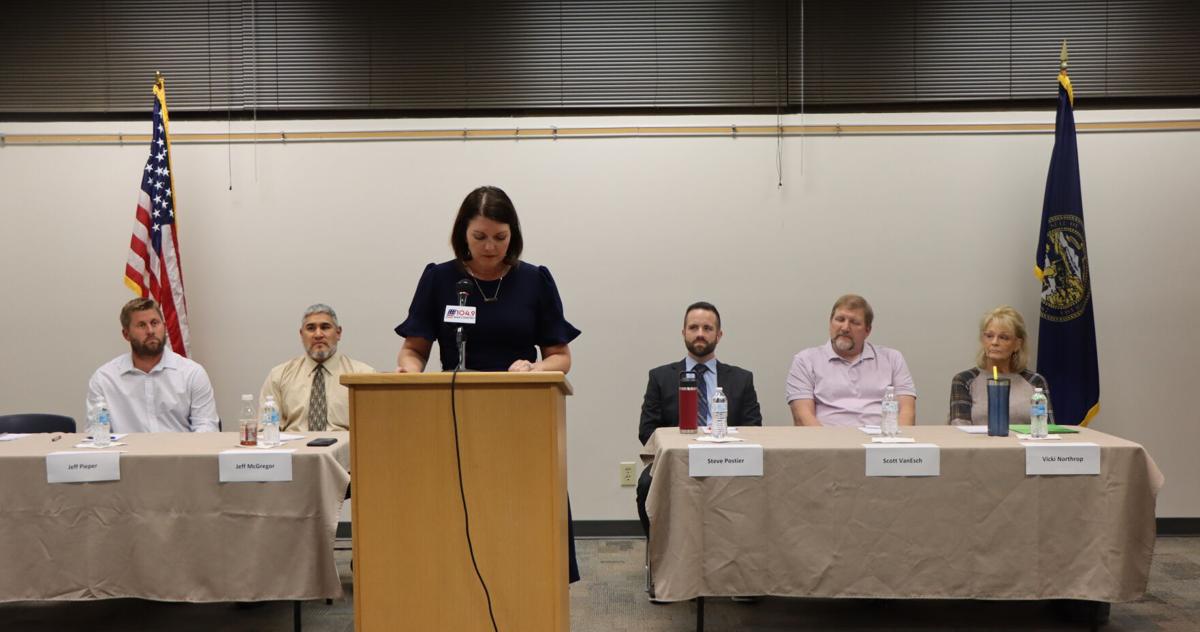From detention center to pipelines, GOP candidates discuss issues at forum

Republicans have a lot to contemplate after this week’s candidates’ forum at the Watertown Event Center.
Primary candidates for the Codington County Commission and Legislative Districts 4 and 5 have discussed issues ranging from the Watertown Detention Center to a planned carbon dioxide pipeline to run through eastern South Dakota.
All of the candidates at the forum were Republicans because those are the races that local voters will decide in the June 7 primary.
Here are some takeaways from Tuesday’s event.
The candidates
Codington County Commission
Codington County Commission District 1 Republicans Lee Gabel and Kerry Jorgenson, both of Watertown, meet in the primary. The winner will qualify for the November 8 general election and will face Raymond Johnson, D-Watertown, to represent the district for four years.
District 4 House
Republican candidates in the primary include incumbent Fred Deutsch of Florence, Adam Grimm of Wallace, Stephanie Sauder of Bryant and Val Rausch of Big Stone City. The top two voters in June will be on the ballot in November with Travis D. Paulson, D-Wallace. Each legislative district has two members of the House.
District 4 includes the southeast corner of Roberts County, as well as most of Clark County and all of Grant, Deuel, rural Codington, and Hamlin counties.
District 5 Senate
Republican voters will choose between Lee Schoenbeck and Colin A. Paulsen, both of Watertown, on June 7. The winner will be unopposed in November. Each legislative constituency has one senator.
District 5 includes most of Watertown.
Codington County Detention Center
Asked about the biggest problem facing Codington County, Gabel and Jorgenson agreed that securing the money to build a new detention center is a significant challenge.
“I think (the cost) shouldn’t be entirely on the county. We shouldn’t be responsible for everything,” Jorgenson said.
As for the jail issue, Gabel thinks one solution is to keep people out of the justice system.

“Making sure the community works together to help people,” he said. “For the community to have assets like faith-based organizations or programs like those of (the Social Services Agency), which can help people and prevent them from getting involved in the justice system.”
District 4 candidates were asked if they would support a half-cent increase in sales tax to help defray construction expenses for a new regional jail.
Legislation has been proposed to address this issue for Codington County and other counties that have no jails at all, Deutsch said. He said he would not support a tax hike, but was invested in finding a solution.
“This summer there will be a study on how to solve this problem,” Deutsch said, referring to a summer legislative study.
Rausch and Grimm both expressed concern about the temporary increase in taxes, as increases often become permanent.
“You accept a little tax increase here and there. Then that tax stays after the sunset clause,” Grimm said.
Gathering knowledge from members of the justice system would help Sauder determine community needs regarding the prison, she said.
“I would like to get their perspective before making a final decision,” Sauder said.
After:June 7 primary poll filled with races for Watertown-area voters
When the question was posed to District 5 candidates, Schoenbeck said he voted against the half-cent sales tax for counties and continued to believe that raising taxes for prisons regional was not the best option.
“It’s a bad idea if you want a regional prison,” Schoenbeck said. “The first thing that will happen if Codington County enacts a half-cent sales tax is that all the counties in the area that will be using the jail will say they don’t need to help” the finance.
Schoenbeck confirmed Deutsch’s earlier statement that the state was looking at ways to help regional jail efforts involving multiple counties, including how to pay for them.
Paulsen said he would also oppose a half-cent sales tax increase.
“I’ve been very strong on keeping sales taxes as low as possible and maybe even lowering them,” he said.
Eminent domain, pipelines, wind turbines
Landowners across the region are worried about a carbon dioxide pipeline project in eastern South Dakota and wind farms. Candidates were asked what they thought of private industry and its use of eminent domain.
Summit Carbon Solutions proposed a 2,000 mile pipeline that would pump liquefied carbon dioxide from 31 ethanol plants in South Dakota, North Dakota, Minnesota, Iowa and Nebraska so it could be stored a mile underground in western North Dakota.
The company seeks the use of eminent domain, with which private land can be taken against a landowner’s will, in return for payment, and converted to public use, if there is a public interest.

For many, there is a difference between the government using eminent domain to, say, build a highway or utility, and a for-profit company being granted permission to use it.
As people have concerns about the safety of carbon dioxide pipelines, Gabel said he understands if they are uncomfortable with a pipeline running through their property. But by working with county zoning officials to help investigate issues, he said he can make informed and fair decisions about eminent domain.
After:Company hopes to remove carbon dioxide from Glacial Lakes Energy ethanol
“As far as the wind turbines, we’ve improved the ordinance significantly. I would have liked to see more setback between homes and wind turbines, but I think it’s significantly improved from what it was,” Gabel said.
Jorgenson voiced support for the CO2 pipeline, but said he doesn’t believe there is a future for wind turbines and that they pose a public safety risk.
“If there was a fire, how do you deal with it? No one can answer that, and there have been fires,” he said.
Paulsen thinks landowners should have more say in what private companies can do with eminent domain.
“I believe in the rights of individuals and landowners, and it is important to protect those rights. It is important that landowners feel confident and comfortable in their position to have the first voice when these companies go address them,” he said.
Schoenbeck noted how essential eminent domain is to the quality of life for South Dakotans.
“If you like to flip the switch and the light comes on, it’s because of eminent domain. The electricity of that switch? It’s not magic,” he said.
Keep education local
Candidates were also asked if the role of the local school district is as important today as it was.
Removing local government from decision-making in South Dakota education was opposed by all candidates in District 4.
“I would like to keep it local, and taking more government away from education would be a plus,” Grimm said. “I think we see the heavy hand of the government trying to push the curriculum forward and allow all sorts of things to come into the school system, which I think would go against our values for the most part. of South Dakota.”
After:Here’s how to vote ahead of South Dakota’s June 7 primary
Living in a small community that has fought to keep its school open, Rausch said he sees the value of a direct stake in local education.
“Local input is the best. We want to know who the teachers are. We want to know who the administrators are,” he said.
Common street service installation
Candidates for the county commission were asked if they supported the county and Watertown having a joint street service facility on land the city recently purchased.
The City Council approved the expenditure of $1.2 million to purchase approximately 27 acres along State Route 20 North for the Streets Service Building. Including the purchase of the land, the new facility is expected to cost approximately $7.5 million.
After:JLG Architects to design and bid for new Streets Department Headquarters for $349,400
“Both the city and the county are parts of local government, so if you find a way to be profitable, you do it,” Gable said. “But you have to be careful with pots of money. If you have funds that were clearly intended for county use, you want to make sure you’re spending those dollars legally.”
Jorgenson is also in favor of sharing the site and costs with Watertown. However, if the purpose of co-locating the facility is to save money for the county and city, he cautions against overspending on construction.
“We don’t need all the glitz and glamor of a new building if it doesn’t help our situation,” he said.






